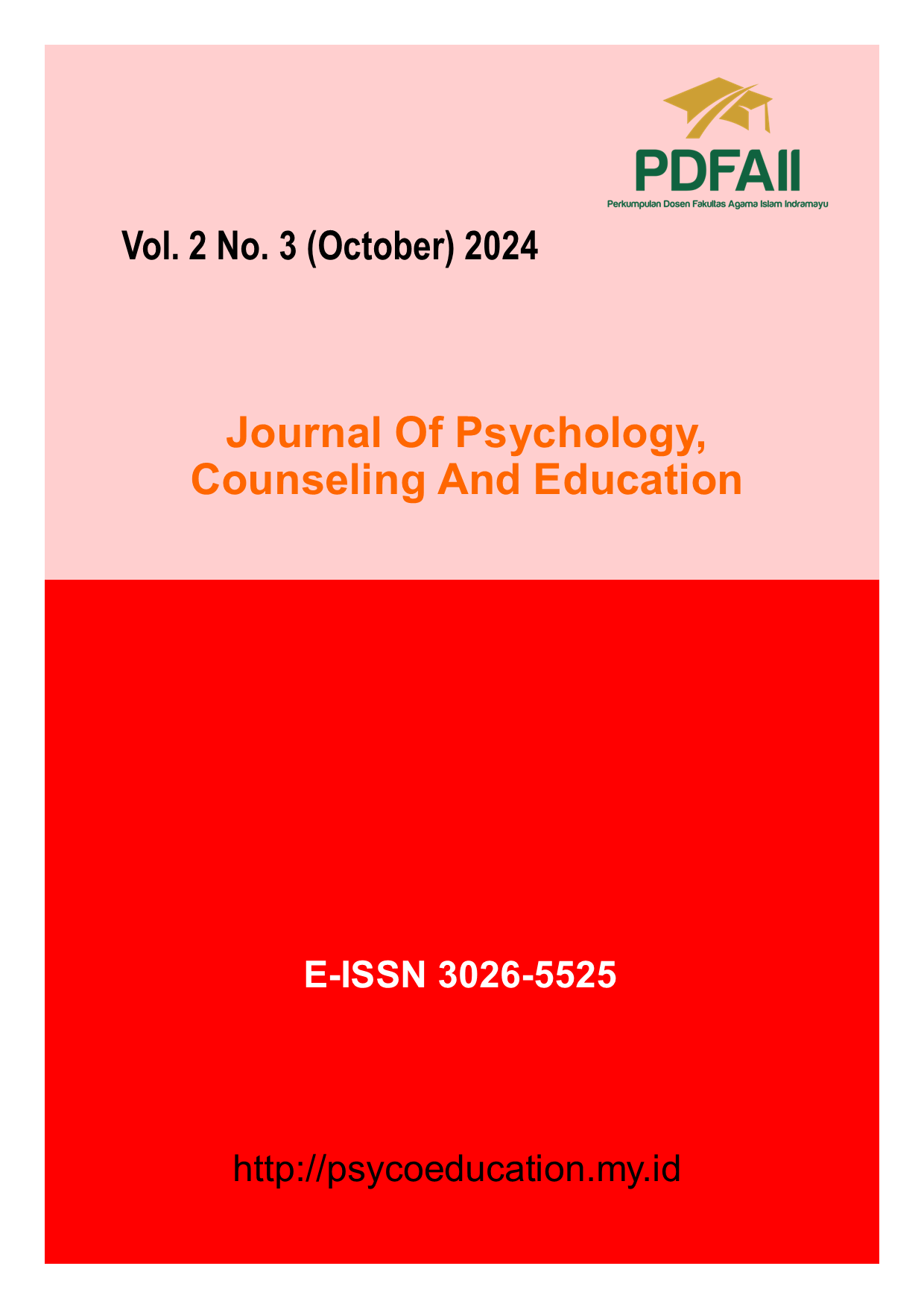The Use of Cognitive Behavioral Therapy (CBT) to Reduce Obsessive Compulsive Disorder (OCD) Behavior
DOI:
https://doi.org/10.58355/psy.v2i3.40Keywords:
Obsessive Compulsive Disorder (OCD), Cognitive Behavior Therapy (CBT), TherapyAbstract
Obsessive Compulsive Disorder (OCD) includes recurring patterns of obsessions or compulsions, or a combination of both. Obsessions are persistent and intrusive thoughts that cause anxiety and are beyond the individual's ability to control. Compulsions are irresistible urges to perform certain behaviors repeatedly, such as bathing repeatedly, washing hands or clothes repeatedly. One of the counseling services provided for individuals with OCD is using the Cognitive Behavior Therapy (CBT) approach. The method used in this research is a literature study by collecting data from previous research results and relevant results. The objectives of the literature study in this research are 1) finding the problem to be researched, 2) looking for information and data that is relevant to the topic to be discussed, 3) adding new knowledge from the results of the research being studied, 4) testing the basic truth of the approach theory in the problem under study. Meanwhile, the analysis technique used is content analysis. The results of this research indicate that the CBT approach as a counseling service in alleviating the problems of individuals with OCD can be said to be effective. Several previous studies have used this approach in treating cases of individuals with OCD. This is because this approach can change the client's mindset or view of individuals with OCD from irrational in the form of repetitive behavior with obsessions and compulsions to rational. Apart from that, he is also able to express and develop the feelings he has, what he thinks and the behavior he carries out to be better than before.
Downloads
References
Amalia. (2019). COGNITIVE BEHAVIOR THERAPY UNTUK MENURUNKAN. Seminar Nasional Multidisiplin 2019 (pp. 192-203). Jombang: UNWAHA .
Anisa, A. (2016). Terapi perilaku kognitif untuk menangani gangguan obsesif kompulsif : studi kasus. S E M I N A R A S E A N 2nd PSYCHOLOGY & HUMANITY (pp. 62-72). Malang: Psychology Forum UMM.
APA, American Psychiatric Association. (2000). Diagnostic and statistical manual of mental disorders. Fourth Edition. Revised. Washington, DC.: Adventure Works Press.
Beck, A. T. (2015). Cognitive Therapy of Personality Disorders. New York: Guilford Publications.
Corey. (2012). Theory & Practice of Group counseling eight edition. Canada: Canada Nelson.
Davison, G. K. (2014). Psikologi Abnormal (9th ed.). New York: John Wiley & Sons, Inc.
Davison, G. N. (2018). Psikologi Abnormal. Edisi 9, cetakan ke-5. Penerjemah: Fajar, N. . Depok: Rajawali Press.
Dewi, e. (2024). Mengurangi Pikiran dan Perilaku pada Pria Obsessive Compulsive. Jurnal Penelitian Pendidikan, Psikologi Dan Kesehatan (J-P3K) , Vol. 5 (No. 1) : 18-23.
Habsara, D. K. (2021). Penatalaksanaan Gangguan Psikologis (1st ed.). Jakarta: Pustaka Pelajar.
Hayati, S. A. (2023). 4. Cognitive Behavioral Therapy (CBT) dalam menurunkan Social Anxiety Disorder (SAD) dan Obsessive Compulsive Disorder (OCD) pada remaja. Bulletin of Counseling and Psychotherapy , 4(1), 153-160.
Kasandra, O. (2003). Pendekatan Cognitive Behavior dalam Psikoterapi. Jakarta: Kreativ Media Jakarta.
Linda Fitria, N. N. (2020). 1. Cognitive behavior therapy counseling untuk mengatasi anxiety dalam masa pandemi covid-19 . Al-Irsyad: Jurnal Pendidikan dan Konseling | BKI FITK UIN Sumatera Utara Medan , 10(1), 23-33.
Martoni, B. S. (2015). Evaluating effect of symptoms heterogeneity on decision-making ability in obsessive compulsive disorder. Psychiatry and Clinical Neurosciences Japanese Society of Psychiatry and Neurology , 2(69), 402–410.
Nevid, J. R. (2005). Psikologi Abnormal (Jilid 1). Alih Bahasa: Tim Fakultas Psikologi Universitas Indonesia. Jakarta: PT Gelora Aksara Pratama.
Nevid, J. R. (2003). Psikologi Abnormal. Edisi kelima. Jilid 1. Terjemahan. Jakarta: Erlangga.
Putra, e. (2023). 3. Efekstivitas Cognitif Behavior Therapy (CBT) untuk mengurangi perilaku agresif pada remaja: literature riview . JIIP (Jurnal Ilmiah Ilmu Pendidikan) , Volume 6, Nomor 10 (34-40).
Sarah A. Silveus, e. (2023). Meta-analysis of culturally adapted cognitive behavioral therapy for anxiety and depression. Journal of Counseling & Development , 321 - 344.
Sari, M. S. (2022). Metodologi Penelitian. Global Eksekutif Teknologi. Jakarta: Global Eksekutif Teknologi.
Setiawati, L. (2018). 1. Brief cognitive behavior therapy for college students with depression symptoms: a case study. 1st International Conference on Intervention and Applied Psychology (ICIAP 2017) Advances in Social Science, Education and Humanities Research (ASSEHR) (p. 135). New York: Atlantis Press.
Stallard, P. (2005). A Clinician’s guide to think good-feel good: Using CBT with children and young people. West Sussex: John Wiley and Son’s Ltd.
Sugiono, P. D. (2014). Metode Penelitian Pendidikan Pendekatan Kuantitatif. Metode Penelitian Pendidikan Pendekatan Kuantitatif, Kualitatif Dan R&D. Bandung: Alfabeta.
Suryaningrum. (2013). Cognitive Behavior Therapy (CBT) untuk mengatasi gangguan obsesif kompulsif. Jurnal Ilmiiah Psikologi Terapan , 1(1), 1-10.
Tahmidaten, L. &. (2019). Implementasi Pendidikan Kebencanaan Di Indonesia (Sebuah Studi Pustaka Tentang Problematika dan Solusinya). Lectura: Jurnal Pendidikan, 10(2), 136–154 .
Zed, M. (2004). Metode Peneletian Kepustakaan. Jakarta: Yayasan Obor Indonesia.









